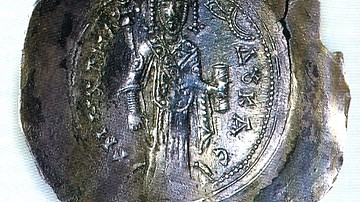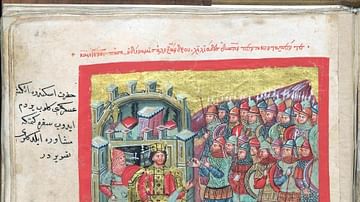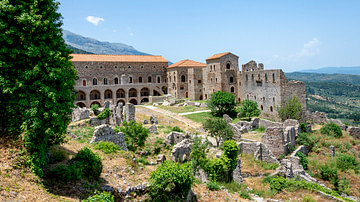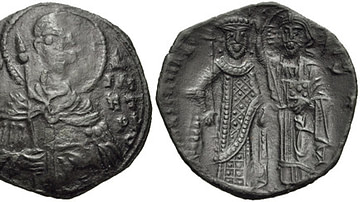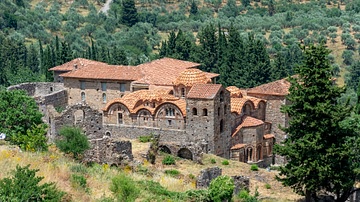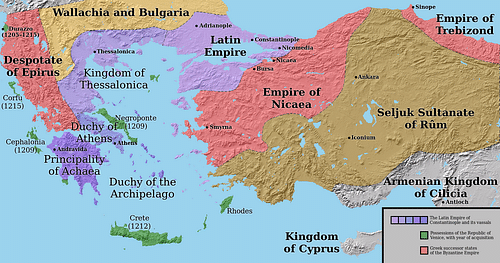
The Empire of Nicaea was a successor state to the Byzantine Empire, or rather a Byzantine Empire in exile lasting from 1204 to 1261 CE. The Empire of Nicaea was founded in the aftermath of the sacking of Constantinople during the Fourth Crusade and the establishment there of the crusader-run Latin Empire in 1204 CE and was ruled by the Laskarid Dynasty. When the forces of Michael VIII Palaiologos recaptured Constantinople in 1261 CE, the Empire of Nicaea, an empire in exile no more, effectively became the Byzantine Empire once again, until it ultimately fell to the Ottoman Turks in 1453 CE.
Birth of Fire & Blood
The sacking of the Byzantine capital of Constantinople shattered the Byzantine Empire. As the Latin crusaders and their Venetian backers established themselves in Europe and in the Aegean islands, three Greek successor states rose up at the peripheries of the empire. The first, and furthest away, was the Empire of Trebizond on the southeastern edge of the Black Sea. Next was the Despotate of Epiros, in modern-day Albania and northwestern Greece. Finally, there was the Empire of Nicaea, centered on the ancient city of Nicaea and controlling northwestern Anatolia.
In addition to the maelstrom of new states were the Bulgarians to the north and the Turks to the east. Battles were fought frequently, alliances were made and broken just as quickly, and who was preeminent in the region was decided by an ever-changing game of thrones. Trebizond was too far away from the center for it to be a serious candidate to reunify Byzantium, and thus it was the Latins, Epirotes, Nicaeans, and the Bulgarians who became the chief contenders for Constantinople.
A Refugee Empire
When it was clear that Constantinople was lost to the Fourth Crusade, Theodore Laskaris fled the city and headed east. Theodore was the son-in-law of Byzantine Emperor Alexios III Angelos (r. 1195-1203 CE), which gave him a semblance of legitimacy and allowed him to rally supporters to his banner. Although he quickly made himself master of the region around Nicaea, in no short part because the new crusader Latin Empire based in Constantinople was attacked and the leadership slaughtered or captured by the Bulgarians under Kaloyan (r. 1196-1207 CE), he still had to compete with the Empire of Trebizond and his father-in-law Alexios III.
Theodore defeated David Megas Komnenos, brother of the Trapezuntine Emperor Alexios I Megas Komnenos (r. 1204-1222 CE), and shortly thereafter proclaimed himself Emperor Theodore I Laskaris (r. 1204-1222 CE). However, Theodore could not convince the exiled Patriarch of Constantinople, John Kamateros, to come to Nicaea from Bulgaria, so he was not officially anointed emperor until 1208 CE when he had the new patriarch do it.
Nicaea was an ideal temporary capital for Byzantium in exile. The wealthy and cultured city had been the seat of two ecumenical councils, was replete with palaces and churches, and had been in Byzantine hands, with the exception of a brief Seljuk occupation at the end of the 11th century, for over 1,000 years.
At the same time, Alexios III, who was still alive and jealous of Theodore's new power, commissioned the Turkish Seljuk Sultan Kaykhusraw I (r. 1192-1196, 1205-1211 CE) to attack the Empire of Nicaea. At the Battle of Antioch on the Meander in 1211 CE, Theodore defeated and killed Kaykhusraw. Alexios III was placed in captivity and died later that year. The new Latin Emperor, Henry of Flanders (r. 1205-1216 CE), took advantage of Theodore's preoccupation with gaining control of the southern shore of the Sea of Marmara. However, Theodore then used David Megas Komnenos' death to take control of Trebizond's western territories. In 1214 CE, Theodore and Henry signed the Treaty of Nymphaion, which (briefly) established peace between the Nicaean and Latin Empires and served as official recognition of the Empire of Nicaea by the Latins, followed by Venice in 1220 CE.
Establishment of an Empire
Theodore's competent rule had kept the Empire of Nicaea alive in the aftermath of the fall of Constantinople, but it would be his successors that set Nicaea up to reestablish the Byzantine Empire. After Theodore died in 1222 CE, he was succeeded by his son-in-law, John III Doukas Vatatzes (r. 1222-1254 CE), who became the most important Nicaean emperor, dominating it for the majority for its existence. After a brief succession dispute, John took the offensive against the Latin Empire, wresting its Asian territories away and even briefly capturing the important city of Adrianople in Europe.
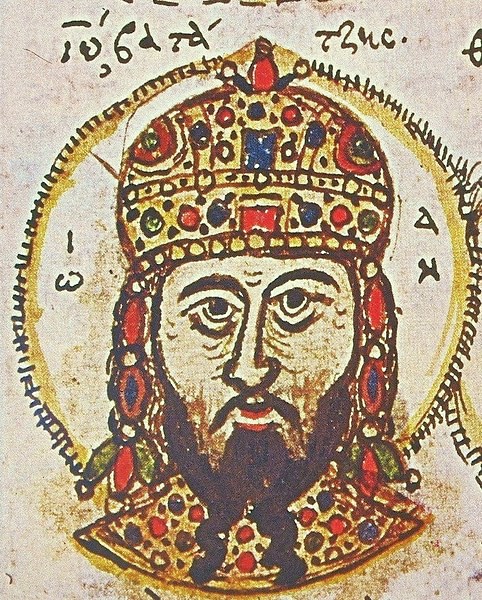
John was pushed back by the powerful Theodore Komnenos Doukas, Despot of Epiros (r. 1215-1230 CE), who had captured Thessalonica and now Adrianople, being declared emperor in the former. It appeared that Theodore would be the one to recapture Constantinople from the Latins, especially as the Bulgarian Tsar Ivan Asen II (r. 1218-1241 CE) menaced Nicaean positions in Europe. But John reaped the benefits when Ivan's forces thrashed Theodore's armies at the Battle of Klokotnitsa after Theodore had invaded Bulgaria. With the effective removal of Epiros as a contender to restore Byzantium, Greek hopes turned to John and the Empire of Nicaea.
Seeing an opportunity, John made an alliance with Ivan against the Latin Empire. The two took over practically all territory outside of Constantinople from the Latin Empire. However, Ivan saw that John and not the dying Latin Empire was the more dangerous enemy, and he started to back the Latin Empire instead, keeping it alive by a thread for now. After Ivan's death in 1241 CE, John captured large swaths of former Byzantine territory in Europe, including the prize of Thessalonica in 1242 CE and most of Thrace and Epiros. John's playing off of Epiros, Bulgaria, and the Latin Empire had worked. The Despotate of Epiros became John's vassal. With a stranglehold around Constantinople, John had positioned the Empire of Nicaea to restore Byzantium.
New Internal Outlooks & Further Foreign Affairs
Due to initially only holding land in Anatolia, the Empire of Nicaea focused on its eastern territories much more than had the last Angeloi emperors of the Byzantine Empire. Theodore and John undertook economic and land management reforms in Anatolia to improve agricultural productivity and generate more wealth for the empire. John encouraged agriculture and lower taxes to boost productivity. The Laskarids also continued the system (pronoia) of leasing properties to private individuals in exchange for managing and protecting them. This all led to a much better cared for and protected Anatolia than had existed under the Angeloi or their predecessors the Komnenoi.
The Empire of Nicaea also began to foster a sense of Greek identity rather than just Roman identity, like the Byzantine Empire had previously done. The Laskarids encouraged education and philosophy in Nicaea and the city soon became renowned as a center of Hellenistic learning. It hosted leading Greek scholars such as Nikephoros Blemmydes and George Akropolites. Nicaean scholars started to talk about being Greek and Hellenism; this was the rise of a Greek identity among the Greek populace, a trend that continued into the restored Byzantine Empire.
Perhaps John's greatest diplomatic feat was concluding a marriage alliance with Frederick II, Holy Roman Emperor (r. 1220-1250 CE) and King of Sicily (r. 1198-1250 CE), the most powerful ruler in Europe. Both men were opposed to the Papacy, which was the root of the alliance. Today this alliance is synonymous with John's reign, and the backing of the powerful Frederick raised the importance of Nicaea in the eyes of Europe. While the friendship lasted through Frederick's death in 1250 CE, relations between the Empire of Nicaea and Sicily unraveled under Frederick's son and successor, Manfred (r. 1258-1266 CE).
John also made an alliance with the Seljuks and the Empire of Trebizond against the Mongols when they invaded the region in the 1230s and 1240s CE. The Mongols crushed the Seljuks, and Trebizond quickly paid tribute, but the Mongols never advanced on Nicaean territory, preserving the empire from almost guaranteed destruction. When John died in 1254 CE, he was remembered as a saint. A successful and beloved ruler, it was he who had set up the Empire of Nicaea to retake Constantinople. It was only a question of when.
Towards the Recapture of Constantinople
John was succeeded by his son, Theodore II Laskaris (r. 1254-1258 CE). Theodore was sickly but was extremely learned, having studied with the best scholars of his age, Blemmydes and Akropolites. He instituted several reforms, among them raising the taxes to recruit soldiers and using native Greek troops instead of foreign mercenaries, as had been the custom since at least the 11th century CE. He also defeated the Bulgarians in two campaigns and won back the important Adriatic port city of Dyrrachium through his marriage to the daughter of the Despot of Epiros. He also managed to keep the Mongols from attacking his empire.
Theodore died young in 1258 CE, leaving his son, the eight-year-old John IV Laskaris (r. 1258-1261 CE) as emperor. The powerful general Michael Palaiologos took advantage of this situation and made himself co-emperor the next year as Michael VIII Palaiologos (r. 1259-1281 CE). Michael crushed a powerful alliance of the Despotate of Epiros, the Latin lords of Greece, and Manfred at the Battle of Pelagonia in 1259 CE. Following the battle, Michael recaptured all Epirote lands outside Epiros itself and lands in southern Greece around the city of Mistras.
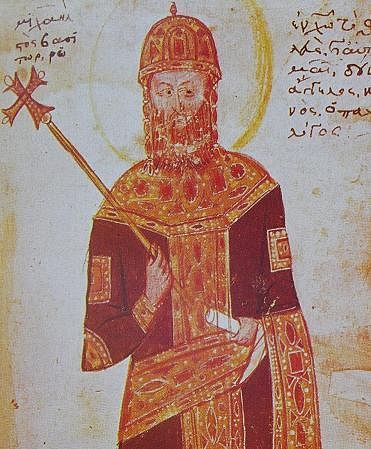
Michael next planned to retake Constantinople. He signed the Treaty of Nymphaeum with Genoa in 1261 CE, granting commercial exceptions to the Genoese in exchange for military support against the Latin Empire. In reality, this was not necessary. Michael's general, Alexios Strategopoulos, was patrolling near the city and, with the Latin Empire's army outside of the city on another mission, Alexios snuck into the city and recaptured Constantinople.
Shortly thereafter, the capital officially changed to Constantinople and the Byzantine Empire was restored. In the minds of the Nicaeans, however, they had always been Byzantines; this was merely the end of their long path to re-establishing themselves in Constantinople. With the capture of Constantinople then, the importance of Nicaea immediately faded and the so-called Empire of Nicaea reverted to being the Byzantine Empire.
Postlude to an Empire
After Strategopoulos captured Constantinople, Michael VIII entered it to proclaim himself Emperor of the Romans. The Byzantine Empire was restored, although only in a weakened shape. It only controlled the western edge of Anatolia, Thrace, most of northern Greece, and parts of southern Greece. The restored Byzantine Empire would go on to survive until 1453 CE, all that while being ruled by Michael's descendants, the Paleologai. Even though Michael is officially the last emperor to rule from Nicaea, it is usually considered that John IV is really the last Nicaean emperor. John IV was left behind in Nicaea when Michael moved to Constantinople, and Michael had John blinded later that year. John was only eleven years old. Like the Empire of Nicaea itself, John was left behind, forgotten as a minor interlude to a restored empire.


